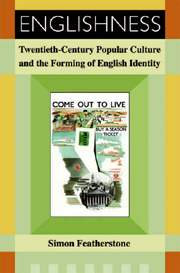4 - Journeys
Published online by Cambridge University Press: 12 September 2012
Summary
In the early 1920s, S. P. B. Mais was travelling near Plumpton. ‘We swept round a corner of the Downs’, he writes, ‘at our feet lay the green and golden carpet of the Sussex weald. Suddenly out of a hidden lane right across our bows came the South Downs hounds, homing after cubbing’. ‘ “My God!”’ says his companion, ‘ “England!” … We were silent: we had all seen a holy thing: we had seen England. None of us will ever be able to communicate what we saw: none of us will ever forget it’ (Mais 1922: 311–12). Mais's English journey, his sudden vision of nationhood and his expression of inexpressible Englishness, embody both the aspirations and the strategies of a popular genre of English travel writing produced in the period around and between the two world wars. Only J. B. Priestley's English Journey (1934) and H. V. Morton's In Search of England (1927) have retained any popular currency, but they are a tiny part of the hundreds of books and essays that recorded journeys by car, bus, horse, foot and bicycle ‘in search of England’. These accounts formed substantial sections of some publishers' lists, whether formalised as a series such as B. T. Batsford's ‘The British Heritage’ or as part of the more informal preoccupations of a company like J. M. Dent. Some writers, including Mais and Morton, made a long career out of finding England.
- Type
- Chapter
- Information
- EnglishnessTwentieth-Century Popular Culture and the Forming of English Identity, pp. 66 - 83Publisher: Edinburgh University PressPrint publication year: 2008



